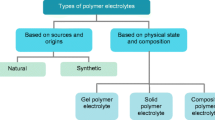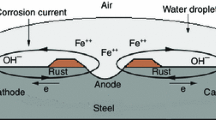Abstract
Polymer electrolyte films of biodegradable poly(ε-caprolactone) (PCL) doped with LiSCN salt in different weight ratios were prepared using solution cast technique. The effect of crystallinity and interaction between lithium ions and carbonyl groups of PCL on the ionic conduction of PCL:LiSCN polymer electrolytes was characterized by X-ray diffraction (XRD), optical microscopy, Fourier transform infrared spectroscopy (FTIR) and AC impedance analysis. The XRD results revealed that the crystallinity of the PCL polymer matrix decreased with an increase in LiSCN salt concentration. The complexation of the salt with the polymer and the interaction of lithium ions with carbonyl groups of PCL were confirmed by FTIR. The ionic conductivity was found to increase with increasing salt concentration until 15 wt% and then to decrease with further increasing salt concentration. In addition, the ionic conductivity of the polymer electrolyte films followed an Arrhenius relation and the activation energy for conduction decreased with increasing LiSCN concentration up to 15 wt%. UV–vis absorption spectra were used to evaluate the optical energy band gaps of the materials. The optical energy band gap shifted to lower energies with increasing LiSCN salt concentration.













Similar content being viewed by others
References
Reddeppa N, Sharma AK, Narasimha Rao VVR, Chen W (2013) Preparation and characterization of pure and KBr doped polymer blend (PVC/PEO) electrolyte thin films. Microelectron Eng 112:57–62
Reddeppa N, Sharma AK, Narasimha Rao VVR, Chen W (2014) AC conduction mechanism and battery discharge characteristics of (PVC/PEO) polyblend films complexed with potassium chloride. Measurement 47:33–41
Chiappone A, Nair JR, Gerbaldi C, Bongiovanni R, Zeno E (2015) UV-cured Al2O3-laden cellulose reinforced polymer electrolyte membranes for Li-based batteries. Electrochim Acta 153:97–105
Wang QJ, Song WL, Fan LZ, Shi Q (2015) Effect of alumina on triethylene glycol diacetate-2-propenoic acid butyl ester composite polymer electrolytes for flexible lithium ion batteries. J Power Sources 279:405–412
Gray FM (1997) Polymer electrolytes, RSC materials monographs. Royal Society of Chemistry, London
Hallinan DT Jr, Balsara NP (2013) Polymer electrolytes. Annu Rev Mater Res 43:503–525
Agrawal RC, Pandey GP (2008) Solid polymer electrolytes: materials designing and all-solid-state battery applications: an overview. J Phys D Appl Phys 41:223001–2230018
Manuel Stephan A, Nahm KS (2006) Review on composite polymer electrolytes for lithium batteries. Polymer 47:5952–5964
Ulaganathan M, Rajendran S (2010) Preparation and characterizations of PVAc/PVdf-HFP)-based polymer blend electrolytes. Ionics 16:515–521
Zhong Z, Cao Q, Wang XY, Wu N, Wang Y (2012) PVC-PMMA composite electrospun membranes as polymer electrolytes for polymer lithium ion batteries. Ionics 18:47–53
Kiran Kumar K, Ravi M, Pavani Y, Bhavani S, Sharma AK, Narasimha Rao VVR (2012) Electrical conduction mechanism in NaCl complexed PEO/PVP polymer blend electrolytes. J Non-Cryst Solids 358:3205–3211
Coombes AGA, Rizzi SC, Williamson M, Barralet JE, Downes S, Wallace WA (2004) Precipitation casting of polycaprolactone for applications in tissue engineering and drug delivery. Biomaterials 25:315–325
Ray SS, Bousmina M (2005) Biodegradable polymers and their layered silicate nanocomposites: in greening the 21st century materials world. Prog Mater Sci 50:962–1079
Patricio T, Gloria A, Bartolo P (2013) Mechanical and biological behaviour of PCL and PCL/PLA scaffolds for tissue engineering applications. Chem Eng Trans 32:1645–1650
Gadjourova Z, Andreev YG, Tunstall DP, Bruce PG (2001) Ionic conductivity in crystalline polymer electrolytes. Nature 412:520–523
Christie AM, Lilley SJ, Staunton E, Andreev YG, Bruce PG (2005) Increasing the conductivity of crystalline polymer electrolytes. Nature 433:50–53
Fonseca CP, Cavalcante F Jr, Amaral FA, Zani Souza CA, Neves S (2007) Thermal and conduction properties of a PCL-biodegradable Gel polymer electrolyte with LiClO4, LiF3CSO3, and LiBF4 salts. Int J Electrochem Sci 2:52–63
Teixeira JCS, Fernandes M, de Zea Bermudez V, Barbosa PC, Rodrigues LC, Silva MM, Smith MJ (2010) Mg2+ doped poly (ε-caprolactone)/siloxane biohybrids. Electrochim Acta 55:1328–1332
Fernandes M, Nobre SS, Rodrigues LC, Gonçalves A, Rego R, Oliveira MC, Ferreira RAS, Fortunato E, Silva MM, Carlos LD, de Zea Bermudez V (2011) Li+ and Eu3+ doped poly (ε-caprolactone)/siloxane biohybrid electrolytes for electrochromic devices. ACS Appl Mater Interfaces 3:2953–2965
Nuves SC, de Zea Bermudez V, Silva MM, Smith MJ, Morales E, Carlos LD, Sa Ferreira RA, Rocha J (2006) Sol–gel derived Li+ doped poly(ε-caprolactone) /siloxane biohybrid electrolytes. J Solid State Electrochem 10:203–210
Woo HJ, Majid SR, Arof AK (2011) Conduction and thermal properties of a proton conducting polymer electrolyte based on poly (ε-caprolactone). Solid State Ionics 199–200:14–20
Wang YF, Ma XY, Zhang QL, Tian N (2010) Synthesis and properties of gel polymer electrolyte membranes based on novel comb-like methyl methacrylate copolymers. J Membr Sci 349:279–286
Khatiwala VK, Shekhar N, Aggarwal S, Mandal UK (2008) Biodegradation of poly(ε-caprolactone) (PCL) film by Alcaligenes faecalis. J Polym Environ 16:61–67
Lee TH, Boey FYC, Khor KA (1995) X-ray diffraction analysis technique for determining the polymer crystallinity in a polyphenylene sulfide composite. Polym Compos 16:481–488
Bhide A, Hariharan K (2007) Ionic transport on (PEO)6:NaPO3 polymer electrolyte plasticized with PEG400. Eur Polym J 43:4253–4270
Kumar Y, Hashmi SA, Pandey GP (2011) Ionic liquid mediated magnesium ion conduction in Poly (ethylene oxide) based polymer electrolyte. Electrochim Acta 56:3864–3873
Mitra S, Kulkarni AR (2002) Electrical conductivity studies on the plasticized PEO-DBP-CdX (X = Cl; SO4) polymer electrolytes. Solid State Ionics 154–155:37–43
Nik Aziz NA, Idris NK, Isa NIM (2010) Solid polymer electrolytes based on methylcellulose: FT-IR and ionic conductivity studies. Int J Polym Anal Charact 15:319–327
Sim LN, Majid SR, Arof AK (2014) Effect of 1-butyl-3methyl imidazolium trifluoromethanesulfonate ionic liquid in poly (ethyl methacrylate)/poly (vinlylidenefluoride-co-hexafluoropropylene) blend based polymer electrolyte system. Electrochim Acta 123:190–197
Tamara E, Mohamad NE, Christelle D, Sophie B, Philippe D (2004) FTIR study of polycaprolactone chain organization at interfaces. J Colloid Interface Sci 273:381–387
Ahmad S, Bohidar HB, Ahmad S, Agnihotry SA (2006) Role of fumed silica on ion conduction and rheology in nanocomposite polymeric electrolytes. Polymer 47:3583–3590
Wu ID, Chang FC (2007) Determination of the interaction within polyester-based solid polymer electrolyte using FTIR spectroscopy. Polymer 48:989–996
Martin-Vosshage D, Chowdari BVR (1993) Characterization of poly (ethylene oxide) with cobaltbromide. Solid State Ionics 62:205–216
Woo HJ, Majid SR, Arof AK (2011) Transference number and structural analysis of proton conducting polymer electrolytes based on ply (ε-caprolactone). Mater Res Innov 15:51–54
Ravi M, Pavani Y, Bhavani S, Sharma AK, Narasimha Rao VVR (2012) Studies on electrical and dielectric properties of PVP:KBrO4 complexed polymer electrolyte films. Mater Chem Phys 130:442–448
Poly AR, Kumar R (2014) Ionic conductivity and Dishcarge Characteristic Studies of PVA-Mg(CH3COO)2 Solid Polymer Electrolytes. Int J Polym Mater Polym Biomater 62:76–80
Nithya S, Selvasekarapandian S, Karthikeyan S, Inbavalli D, Sikkinthar S, Sanjeeviraja C (2014) AC impedance studies on proton-conducting PAN:NH4SCN polymer electrolytes. Ionics 20:1391–1398
Fonseca CP, Neves S (2002) Characterization of polymer electrolytes based on poly (dimethyl silozane-co-ethylene oxide). J Power Sources 104:85–89
Ravi M, Pavani Y, Bhavani S, Sharma AK, Narasimha Rao VVR (2012) Investigations on structural and electrical properties of KClO4 complexed PVP polymer electrolyte films. Int J Polym Mater Polym Biomater 61:309–322
Miyamoto T, Shibayama K (1973) Free-volume model for ionic conductivity in polymers. J Appl Phys 44:5372–5376
Yang JM, Wang NC, Chiu HC (2014) Preparation and characterization of poly (vinyl alcohol)/sodium alginate blended membrane for alkaline solid polymer electrolytes membrane. J Membr Sci 457:139–148
Ramesh S, Arof AK (2001) Ionic conductivity studies of plasticized poly (vinyl chloride) polymer electrolytes. Mater Sci Eng B 85:11–15
Thutupalli GM, Tomlin SG (1976) The optical properties of thin films of cadmium and zinc selenides and tellurides. J Phys D Appl Phys 9:1639–1646
Davis EA, Shalliday TS (1960) Some optical properties of cadmium telluride. Phys Rev 118:1020–1022
Mansingh A, Kumar S (1988) Optical properties of As-grown and reduced TeO2 films. Thin Solid Films 161:101–106
Fonseca CP, Rosa DS, Gaboardi F, Neves S (2006) Development of a biodegradable polymer electrolyte for rechargeable batteries. J Power Sources 155:381–384
Polo Fonseca C, Neves S (2006) Electrochemical properties of a biodegradable polymer electrolyte applied to a rechargeable lithium battery. J Power Sources 159:712–716
Nuves SC, de Zea BV, Ostrovskii D, Martinz NV (2008) Vibrational spectra and microstructure of poly (ε-caprolactone)/siloxane biohybrides doped with lithium triflate. J Mol Struct 879:72–80
Rodrigues LC, Silva MM, Smith MJ, Goncalves A, Fortunato E (2012) Poly (ε-caprolactone)/siloxane biohybrids with application in “smart windows”. Synth Met 161:2682–2687
Fernandes M, Rodrigues LC, Ferreira RAS, Goncalves A, Fortunato E, Silva MM, Smith MJ, Carlos LD, de Zea Bermudes V (2011) K+-doped poly(ε-caprolactone)/siloxane biohybrid electrolytes for electrochromic devices. Solid State Ionics 204–205:129–139
Woo HJ, Majid SR, Afor AK (2012) Dielectric properties and morphology of polymer electrolytes based on poly (ε-caprolactone) and ammonium thiocyanate. Mater Chem Phys 134:755–761
Chiu CY, Chen HW, Kuo SW, Huang CF, Chang FC (2004) Investigating the effect of miscibility on the ionic conductivity of LiClO4/PEO/PCL ternary blends. Macromolecules 37:8424–8430
Sownthari K, Austin Suthanthiraraj S (2014) Structural, thermal, and electrical studies on gel polymer electrolytes containing 1-ethyl-3-methylimidazolium bis(trifluoromethylsulfonyl) imide. Ionics. doi:10.1007/s11581-014-1324-8
Pandey GP, Hashmi SA (2009) Experimental investigations of an ionic-liquid-based, magnesium ion conducting, polymer gel electrolyte. J Power Sources 187:627–634
Acknowledgments
This research was supported by the Science and Technology Foundation of Shenzhen.
Author information
Authors and Affiliations
Corresponding author
Rights and permissions
About this article
Cite this article
Ravi, M., Song, SH., Gu, KM. et al. Effect of lithium thiocyanate addition on the structural and electrical properties of biodegradable poly(ε-caprolactone) polymer films. Ionics 21, 2171–2183 (2015). https://doi.org/10.1007/s11581-015-1384-4
Received:
Revised:
Accepted:
Published:
Issue Date:
DOI: https://doi.org/10.1007/s11581-015-1384-4




